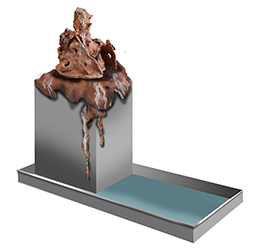This project is part of an ongoing investigation, which relates the search for gold and silver in the 16th century by the Spanish since their arrival in these lands, with the current extraction of lithium in Argentina and neighboring countries. There was no silver in the Río de la Plata, the mountain sought turned out to be Cerro Rico de Potosí. Extractivisms -and exterminations- from the beginnings of European expansionist modernity to the current global dystopia: the voracity is the same.
The title “A silver mountain in the Solís River” comes from a chapter in the book “Those who built the Río de la Plata”, by the historian Juliana Gandini. In the project, the ceramics take the organic forms of the earth, craftsmanship as an ancestral attitude. Its holes allude to extractivism, and the silver spills to the fantasy after which the Spanish settled in this territory.
The metallic elements, prism and pan, are signs of the contemporary, post-industrial digital era. The punt is related to the lithium extraction pits.
Both materials contrast: artisanal and organic red ceramics, metal prisms. The silver luster spills link them visually.
(Work in progress)
The title “A silver mountain in the Solís River” comes from a chapter in the book “Those who built the Río de la Plata”, by the historian Juliana Gandini. In the project, the ceramics take the organic forms of the earth, craftsmanship as an ancestral attitude. Its holes allude to extractivism, and the silver spills to the fantasy after which the Spanish settled in this territory.
The metallic elements, prism and pan, are signs of the contemporary, post-industrial digital era. The punt is related to the lithium extraction pits.
Both materials contrast: artisanal and organic red ceramics, metal prisms. The silver luster spills link them visually.
(Work in progress)

